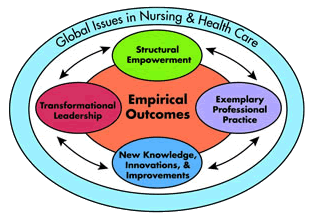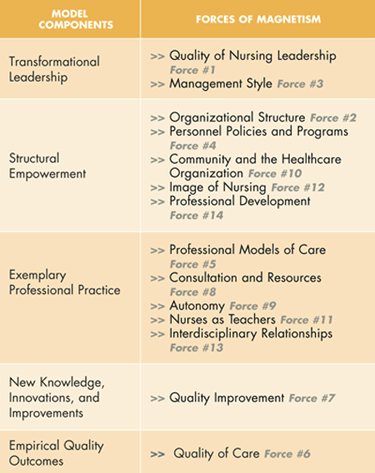Magnet Model - Creating a Magnet Culture
The American Nurses Credentialing Center (ANCC) is pleased to present the next generation model for its esteemed Magnet Recognition Program®. This new model is designed to provide a framework for nursing practice and research in the future, as well as serving as a roadmap for organizations seeking to achieve Magnet recognition.
ANCC commissioned a statistical analysis of Magnet appraisal team scores from evaluations conducted using the 2005 Magnet Recognition Program Application Manual. This analysis clustered the sources of evidence into more than 30 groups. These groups of sources of evidence yielded an empirical model for the Magnet Recognition Program.
To provide greater clarity and direction, as well as eliminate redundancy within the Forces of Magnetism, the new model configures the 14 Forces of Magnetism into 5 Model Components. The new, simpler model reflects a greater focus on measuring outcomes and allows for more streamlined documentation, while retaining the 14 Forces as foundational to the program.
The Commission on Magnet created a new vision to communicate the importance of Magnet organizations in shaping future changes that are essential to the continued development of the nursing profession and to quality outcomes in patient care.
A New Vision for Magnet
 ANCC Magnet-recognized organizations will serve as the fount of knowledge and expertise for the delivery of nursing care globally. They will be solidly grounded in core Magnet principles, flexible, and constantly striving for discovery and innovation. They will lead the reformation of health care; the discipline of nursing; and care of the patient, family, and community. Overarching the new Magnet Model Components is an acknowledgment of Global Issues in Nursing and Health Care. While not technically a Component, this category includes the various factors and challenges facing nursing and health care today. Below is a description of the 5 Model Components and the Forces of Magnetism that they contain.
ANCC Magnet-recognized organizations will serve as the fount of knowledge and expertise for the delivery of nursing care globally. They will be solidly grounded in core Magnet principles, flexible, and constantly striving for discovery and innovation. They will lead the reformation of health care; the discipline of nursing; and care of the patient, family, and community. Overarching the new Magnet Model Components is an acknowledgment of Global Issues in Nursing and Health Care. While not technically a Component, this category includes the various factors and challenges facing nursing and health care today. Below is a description of the 5 Model Components and the Forces of Magnetism that they contain.
I. Transformational Leadership
Today's health care environment is experiencing unprecedented, intense reformation. Unlike yesterday's leadership requirement for stabilization and growth, today's leaders are required to transform their organization's values, beliefs, and behaviors. It is relatively easy to lead people where they want to go; the transformational leader must lead people to where they need to be in order to meet the demands of the future. This requires vision, influence, clinical knowledge, and a strong expertise relating to professional nursing practice. It also acknowledges that transformation may create turbulence and involve atypical approaches to solutions.
The organization's senior leadership team creates the vision for the future, and the systems and environment necessary to achieve that vision. They must enlighten the organization as to why change is necessary, and communicate each department's part in achieving that change. They must listen, challenge, influence, and affirm as the organization makes its way into the future. Gradually, this transformational way of thinking should take root in the organization and become even stronger as other leaders adapt to this way of thinking.
The intent of this Model Component is no longer just to solve problems, fix broken systems, and empower staff, but to actually transform the organizations to meet the future. Magnet-recognized organizations today strive for stabilization; however, healthcare reformation calls for a type of controlled destabilization that births new ideas and innovations.
Forces of Magnetism Represented
- Quality of Nursing Leadership (Force #1)
- Management Style (Force #3)
II. Structural Empowerment
Solid structures and processes developed by influential leadership provide an innovative environment where strong professional practice flourishes and where the mission, vision, and values come to life to achieve the outcomes believed to be important for the organization. Further strengthening practice are the strong relationships and partnerships developed among all types of community organizations to improve patient outcomes and the health of the communities they serve. This is accomplished through the organization's strategic plan, structure, systems, policies, and programs. Staff need to be developed, directed, and empowered to find the best way to accomplish the organizational goals and achieve desired outcomes. This may be accomplished through a variety of structures and programs; one size does not fit all. Forces of Magnetism Represented
- Organizational Structure (Force #2)
- Personnel Policies and Programs (Force #4)
- Community and the Healthcare Organization (Force #10)
- Image of Nursing (Force #12)
- Professional Development (Force #14)
III. Exemplary Professional Practice
The true essence of a Magnet organization stems from exemplary professional practice within nursing. This entails a comprehensive understanding of the role of nursing; the application of that role with patients, families, communities, and the interdisciplinary team; and the application of new knowledge and evidence. The goal of this Component is more than the establishment of strong professional practice; it is what that professional practice can achieve. Forces of Magnetism Represented
- Professional Models of Care (Force #5)
- Consultation and Resources (Force #8)
- Autonomy (Force #9)
- Nurses as Teachers (Force #11)
- Interdisciplinary Relationships (Force #13)
IV. New Knowledge, Innovation, & Improvements
Strong leadership, empowered professionals, and exemplary practice are essential building blocks for Magnet-recognized organizations, but they are not the final goals. Magnet organizations have an ethical and professional responsibility to contribute to patient care, the organization, and the profession in terms of new knowledge, innovations, and improvements. Our current systems and practices need to be redesigned and redefined if we are to be successful in the future. This Component includes new models of care, application of existing evidence, new evidence, and visible contributions to the science of nursing.
Forces of Magnetism Represented
- Quality Improvement (Force #7)
V. Empirical Quality Results
Today's Magnet recognition process primarily focuses on structure and processes, with an assumption that good outcomes will follow. Currently, outcomes are not specified, and are minimally weighted. There are no quantitative outcome requirements for ANCC Magnet Recognition ®. Recently lacking were benchmark data that would allow comparisons with best practices. This area is where the greatest changes need to occur. Data of this caliber will spur needed changes.
In the future, having a strong structure and processes are the first steps. In other words, the question for the future is not "What do you do?" or "How do you do it?" but rather, "What difference have you made?" Magnet-recognized organizations are in a unique position to become pioneers of the future and to demonstrate solutions to numerous problems inherent in our healthcare systems today. They may do this in a variety of ways through innovative structure and various processes, and they ought to be recognized, not penalized, for their inventiveness.
Outcomes need to be categorized in terms of clinical outcomes related to nursing; workforce outcomes; patient and consumer outcomes; and organizational outcomes. When possible, outcomes data that the organization already collects should be utilized. Quantitative benchmarks should be established. These outcomes will represent the "report card" of a Magnet-recognized organization, and a simple way of demonstrating excellence.
Forces of Magnetism Represented
- Quality of Care (Force #6)

The new ANCC Magnet Application Manual will incorporate these 5 Model Components as the primary basis for achieving Magnet recognition, with the 14 Forces of Magnetism remaining as the foundation of the program.
The sources of evidence, consolidated to eliminate redundancy and streamline the documentation process, will be reviewed by selected members of the Magnet community prior to the launch of the new Application Manual in 2008.